GMRC Review: Divide and Rule by L. Sprague de Camp
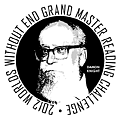 Chris Uhl (chuhl) can’t remember a time when he wasn’t a science fiction fan. He has a B.A. in Classics from Vassar College and an M.A. in English Literature from the University of Virginia. He has worked as a teacher, a legal assistant, a college development officer, a salesman, and a film extra. Chris may be the only WWEnd reviewer who has no blog. This is his first GMRC review to feature in the WWEnd blog.
Chris Uhl (chuhl) can’t remember a time when he wasn’t a science fiction fan. He has a B.A. in Classics from Vassar College and an M.A. in English Literature from the University of Virginia. He has worked as a teacher, a legal assistant, a college development officer, a salesman, and a film extra. Chris may be the only WWEnd reviewer who has no blog. This is his first GMRC review to feature in the WWEnd blog.
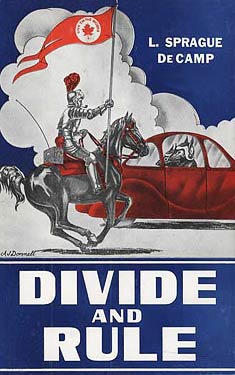 When I saw the synopsis of L. Sprague de Camp‘s Divide and Rule, I knew I had to read it. It takes place in the 23rd century in Poughkeepsie, NY. Poughkeepsie happens to be my hometown, and during my Junior Year Abroad in England, they actually called me “the Duke of Poughkeepsie.” So this is my story.
When I saw the synopsis of L. Sprague de Camp‘s Divide and Rule, I knew I had to read it. It takes place in the 23rd century in Poughkeepsie, NY. Poughkeepsie happens to be my hometown, and during my Junior Year Abroad in England, they actually called me “the Duke of Poughkeepsie.” So this is my story.
Assuming, of course, that I survive to the 23rd century, when the Hudson Valley, like the rest of the planet, will be conquered by “hoppers,” aliens who look like oversized kangaroos. The hoppers will ban high tech and reduce America to a state of medieval feudalism. As if that weren’t bad enough, Poughkeepsie will be at war with Danbury, CT over high tolls. So it looks like I’ll have my work cut out for me.
The point of the story is the juxtaposition of the medieval and the modern. When these New Yorkers talk about the new model Ford, they’re not talking about cars, they’re talking about suits of armor. And they use 20th-century American slang to describe their chivalric adventures.
The problem for me at first was that de Camp doesn’t delve too deeply into the implications of this society beyond the bare description. It’s an interesting setup – let’s explore it! It’s fun to bandy around names like Baron Peekskill and hear about knights fighting at the Battle of Mt. Kisco, but once the novelty of medieval New York wears off – and I would think that the novelty would carry me along further than most readers – then what? The juxtaposition between the medieval and the modern loses its impact when the “modern” now seems a bit quaint to the contemporary reader.
The story starts to fall between two stools – not quite satisfying as science fiction or as historical novel – and like a knight it full armor, it has trouble getting up again.
But it does rise up, when our hero finds himself forced to kill a hopper to defend himself and a damsel in distress. In a nicely-observed description of the moment immediately afterwards, DeCamp writes:
“Sir Howard leaned on his sword, waiting for the roaring in his ears to cease. He knew that he had come as near to fainting as he ever had in his life. A few feet away lay the hopper’s head, the beady eyes staring blankly. The rest of the hopper lay at his feet, its limbs jerking slightly, pushing the sand up into little piles with its hands and feet. Blue-green blood spread out in a widening pool. A few pine needles gyrated slowly on its surface.”
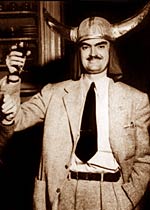 From that moment on, there’s no going back, and the story gains new power as our feckless knight-errant changes into a man with a purpose.
From that moment on, there’s no going back, and the story gains new power as our feckless knight-errant changes into a man with a purpose.
Divide and Rule is dedicated “To Bob Heinlein,” and I imagine that Heinlein must have been pleased with the offering. It’s his kind of story, with scrappy, pragmatic characters getting their political education at the hands of a didactic, Wise Old Man. But the resistance leader in this story is a gentler, more patient man than the cantankerous gurus of Heinlein.
And Sir Howard is a bit like the protagonist in a Heinlein juvenile. He’s a mature adult, but intellectually and politically he’s been kept in a state of arrested adolescence by his alien overlords. Once his consciousness is raised, though, he’s quick to make up for lost time, and so is de Camp.
Forays into Fantasy: The Compleat Enchanter by L. Sprague de Camp and Fletcher Pratt
Scott Lazerus is a Professor of Economics at Western State College in Gunnison, Colorado, and has been a science fiction fan since the 1970s. Recently, he began branching out into fantasy, and was surprised by the diversity of the genre. It’s not all wizards, elves, and dragons! Scott’s new blog series, Forays into Fantasy, is an SF fan’s exploration of the various threads of fantastic literature that have led to the wide variety of fantasy found today. FiF will examine some of the most interesting landmark books of the past, along with a few of today’s most acclaimed fantasies, building up an understanding of the connections between fantasy’s origins, its touchstones, and its many strands of influence.
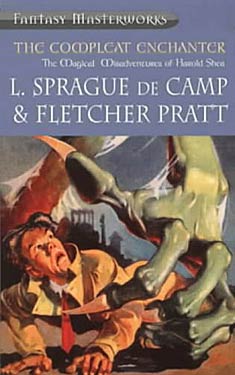 In 1939, L. Sprague de Camp, just embarking on a writing career, was introduced to Fletcher Pratt, who had published a number of stories in the science fiction pulps beginning in 1928, while working for Hugo Gernsback as a translator of European SF stories. De Camp became a regular at Pratt’s gatherings based around his elaborate naval war games. When John W. Campbell‘s Unknown fantasy magazine debuted in 1939, Pratt suggested a collaboration between the two authors–a series of novellas "about a hero who projects himself into the parallel worlds described in our world in myths and legends. We made our protagonist a brash, self-conceited young psychologist named Harold Shea," as de Camp explains in his 1975 essay "Fletcher and I."
In 1939, L. Sprague de Camp, just embarking on a writing career, was introduced to Fletcher Pratt, who had published a number of stories in the science fiction pulps beginning in 1928, while working for Hugo Gernsback as a translator of European SF stories. De Camp became a regular at Pratt’s gatherings based around his elaborate naval war games. When John W. Campbell‘s Unknown fantasy magazine debuted in 1939, Pratt suggested a collaboration between the two authors–a series of novellas "about a hero who projects himself into the parallel worlds described in our world in myths and legends. We made our protagonist a brash, self-conceited young psychologist named Harold Shea," as de Camp explains in his 1975 essay "Fletcher and I."
De Camp credits Pratt with the original idea behind the series, and considers him the "senior member" of the collaboration. They brainstormed the plots together, with Pratt providing most of the background for the stories’ mythological and literary settings. De Camp would take notes, and then write a rough draft, which Pratt would turn into a final draft. Lastly, de Camp would make the final edits prior to sending them to Campbell. The stories were a perfect fit for Unknown, where the first three novellas were published in 1940 and 1941. As John Clute and John Grant explain in The Encyclopedia of Fantasy, "Campbell sought to ensure the fantasy elements in Unknown obeyed some set of laws, in effect treating the supernatural as another science."
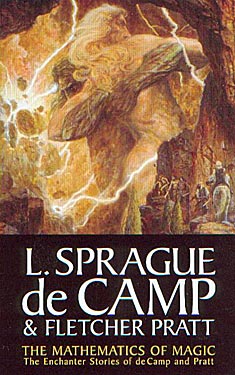 The title of the second novella, "The Mathematics of Magic" (1940), nicely encapsulates the rationalized approach to fantasy Campbell was looking for in the magazine. In each story, a mental technique developed by a group of psychologists is used to transport Shea and his companions to an alternate universe based on a national mythology or well-known literary setting. As lead psychologist Dr. Chalmers puts it, "the method consists of filling your mind with the fundamental assumptions of the world in question…. If one of these infinite other worlds–which up to now may be said to exist in a logical but not in an empirical sense–is governed by magic, you might expect to find a principle like that of dependence invalid, but principles of magic, such as the Law of Similarity, valid." Our world, in which cause and effect are linked by physical laws (dependence), is then replaced by a world where "effects resemble causes. It’s not valid for us, but primitive peoples firmly believe it. For instance, they think you can make it rain by pouring water on the ground with appropriate mumbo jumbo." By internalizing these magical laws, our heroes not only transport themselves to alternate worlds, but, once achieving a thorough enough understanding of the laws of these worlds, become practicing magicians there.
The title of the second novella, "The Mathematics of Magic" (1940), nicely encapsulates the rationalized approach to fantasy Campbell was looking for in the magazine. In each story, a mental technique developed by a group of psychologists is used to transport Shea and his companions to an alternate universe based on a national mythology or well-known literary setting. As lead psychologist Dr. Chalmers puts it, "the method consists of filling your mind with the fundamental assumptions of the world in question…. If one of these infinite other worlds–which up to now may be said to exist in a logical but not in an empirical sense–is governed by magic, you might expect to find a principle like that of dependence invalid, but principles of magic, such as the Law of Similarity, valid." Our world, in which cause and effect are linked by physical laws (dependence), is then replaced by a world where "effects resemble causes. It’s not valid for us, but primitive peoples firmly believe it. For instance, they think you can make it rain by pouring water on the ground with appropriate mumbo jumbo." By internalizing these magical laws, our heroes not only transport themselves to alternate worlds, but, once achieving a thorough enough understanding of the laws of these worlds, become practicing magicians there.
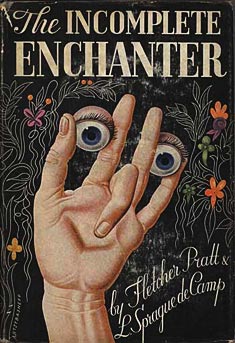 In the first novella, "The Roaring Trumpet" (1940), Shea, feeling vaguely dissatisfied with his humdrum life in Ohio and yearning for adventure, fires up the "syllogismobile" (his irreverent term for the logical formulations used for inter-universe transportation) for a trip to the world of Irish legend. But Shea has not grasped Dr. Chalmers concepts quite well enough to control the process precisely, and ends up in the wrong legend–that of Norse mythology. Shea is also unprepared for how to make use of magic in this world, but he gradually figures it out, becoming more proficient as he learns how the laws work. This partial understanding of the rules of the worlds he and his companions travel to means that the magic often doesn’t go quite right–the main source of the humor for which the series is known. In "The Mathematics of Magic", Shea and Chalmers, trying to conjure a dragon, get the qualitative aspect of the spell correct, but can’t nail down the quantitative. Instead of one dragon, they get 100; on the second attempt, they get .01 (a mini-dragon). They can’t figure out how to get the decimal point in the right place.
In the first novella, "The Roaring Trumpet" (1940), Shea, feeling vaguely dissatisfied with his humdrum life in Ohio and yearning for adventure, fires up the "syllogismobile" (his irreverent term for the logical formulations used for inter-universe transportation) for a trip to the world of Irish legend. But Shea has not grasped Dr. Chalmers concepts quite well enough to control the process precisely, and ends up in the wrong legend–that of Norse mythology. Shea is also unprepared for how to make use of magic in this world, but he gradually figures it out, becoming more proficient as he learns how the laws work. This partial understanding of the rules of the worlds he and his companions travel to means that the magic often doesn’t go quite right–the main source of the humor for which the series is known. In "The Mathematics of Magic", Shea and Chalmers, trying to conjure a dragon, get the qualitative aspect of the spell correct, but can’t nail down the quantitative. Instead of one dragon, they get 100; on the second attempt, they get .01 (a mini-dragon). They can’t figure out how to get the decimal point in the right place.
In another example, at the end of "The Roaring Trumpet," Shea comes up with a spell to get Heimdall and himself to Ragnarok on time by riding flying broomsticks, but the spell is not precise enough to include a reliable means of controlling their flight:
"Shea gripped the stick till his knuckles were white. Up – up – up he went, till everything was blotted out in the damp opaqueness of cloud. The broom rushed on at a steeper and steeper angle, till Shea found to his horror that it was rearing over backward. He wound his legs around the stick and clung, while the broom hung for a second suspended at the top of its loop with Shea dangling beneath. It dived, then fell over sidewise, spun this way and that, with its passenger flopping like a bell clapper."
 These misapplied spells, used for comedic effect, are a hallmark of the stories, and a source of the title of the book that combines the first two novellas, and by which the series itself has come to be known–The Incomplete Enchanter (1941). As for the plot, after becoming magically proficient and helping the Norse gods in the run-up to Ragnarok, Shea is sent home by a witch prior to the world-ending battle. Making better preparations this time, Shea and Chalmers, in "The Mathematics of Magic," travel to the world of Spenser’s The Faerie Queen (1596). While helping Queen Gloriana defeat a cabal of evil magicians (ending with a rather startling scene of magical massacre), Shea meets the huntress Belphebe, who will become his wife and travel with him back to Ohio at story’s end, while Chalmers stays behind, having fallen for a magical doppelganger of Lady Florimel, who he hopes to transform into a real woman once he masters enough magic.
These misapplied spells, used for comedic effect, are a hallmark of the stories, and a source of the title of the book that combines the first two novellas, and by which the series itself has come to be known–The Incomplete Enchanter (1941). As for the plot, after becoming magically proficient and helping the Norse gods in the run-up to Ragnarok, Shea is sent home by a witch prior to the world-ending battle. Making better preparations this time, Shea and Chalmers, in "The Mathematics of Magic," travel to the world of Spenser’s The Faerie Queen (1596). While helping Queen Gloriana defeat a cabal of evil magicians (ending with a rather startling scene of magical massacre), Shea meets the huntress Belphebe, who will become his wife and travel with him back to Ohio at story’s end, while Chalmers stays behind, having fallen for a magical doppelganger of Lady Florimel, who he hopes to transform into a real woman once he masters enough magic.
A third story, "The Castle of Iron," appeared in Unknown in 1941, and was later expanded into a novel published in 1950. The three stories would ultimately be collected in 1975 as The Compleat Enchanter. This time, Chalmers has transported himself from the world of The Faerie Queen to the world of its literary source–Ariosto’s Orlando Furioso (1532), based on legends of the conflict between Charlemagne’s knights and the Saracens attempting to invade Europe in the eighth century–hoping to get assistance from that world’s sorcerers in restoring Florimel to humanity. In another example of "incomplete enchantment," Chalmers, attempting to snatch Shea from Ohio in order to assist his magical studies, ends up with Belphebe instead. Now in Ariosto’s world instead of Spenser’s, Belphebe becomes Belphagor, the corresponding character in Orlando Furioso, with no memory of her previous adventures or her marriage to Shea. Confined to the eponymous castle by a powerful sorcerer, Shea and his companions must master the rules of Ariosto’s magical world in order to restore Belphebe and Florimel, while avoiding getting caught in the middle of the local conflict. Their misadventures involve, among other magical madness, infantile Paladins, a mistaken werewolf, a hippogriff and a magic carpet, culminating with a storming sorcerers’ battle.
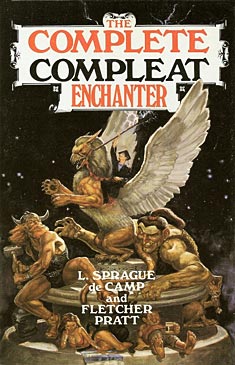 After expanding "The Castle of Iron", de Camp and Pratt went on to publish two more novellas–"The Wall of Serpents" in 1953 and "The Green Magician" in 1954. The full sequence of five eventually appeared as The Complete Compleat Enchanter. (The Fantasy Masterworks version of The Compleat Enchanter also contains all five stories. The NESFA Press collection titled The Mathematics of Magic also includes all the stories, with the addition of two more Shea stories written by de Camp in the early ‘90s.) In "The Wall of Serpents", Shea visits the world of Finnish mythology as described in the Kalevala, and finally makes it to Ireland in "The Green Magician", but the formula has become a little tiresome by that point.
After expanding "The Castle of Iron", de Camp and Pratt went on to publish two more novellas–"The Wall of Serpents" in 1953 and "The Green Magician" in 1954. The full sequence of five eventually appeared as The Complete Compleat Enchanter. (The Fantasy Masterworks version of The Compleat Enchanter also contains all five stories. The NESFA Press collection titled The Mathematics of Magic also includes all the stories, with the addition of two more Shea stories written by de Camp in the early ‘90s.) In "The Wall of Serpents", Shea visits the world of Finnish mythology as described in the Kalevala, and finally makes it to Ireland in "The Green Magician", but the formula has become a little tiresome by that point.
The basic idea is always the same–our heroes arrive in a new world where they must learn the rules of magic in order to help avert a catastrophe and find their way home. The strength of the stories is not in the plotting, but in the comedy and the excitement created by the incidents which tumble on one after another as the stories progress. The stories are also notable for their tone of near-intoxication induced in the characters and reader as a result of the pure exhilaration of their travels into the worlds of magic. (But, as with other sorts of intoxication, it can be overdone, and I was having a hard time continuing with the fourth and fifth novellas, as they began to seem repetitive. This is a series probably best experienced in smaller doses.) As in Silverlock, which also made use of Orlando Furioso as a major source (and whose author, John Myers Myers, was probably influenced by the Shea stories when writing his 1949 novel), immersion in the world of stories is a transformative and life-enhancing experience for characters who feel repressed by their mundane lives. By extension, this idea might be seen to represent the value of fantasy itself to its readers.
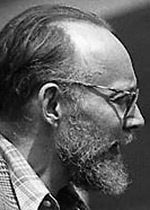 Along with being a key exemplar of Unknown-style fantasy, the Incomplete Enchanter sequence also fits into a long tradition of humorous fantasy, stretching back to A Midsummer Night’s Dream and forward to Terry Pratchett. Pratt and de Camp certainly would have known the work of James Branch Cabell and Thorne Smith, published earlier in the century, which mixes mythology, fantasy, and social satire. In turn, de Camp and Pratt would influence the humorous fantasies of Piers Anthony, Robert Asprin, and many others. In the 1990s, Baen would publish two anthologies of new Harold Shea stories by modern authors influenced by the series.
Along with being a key exemplar of Unknown-style fantasy, the Incomplete Enchanter sequence also fits into a long tradition of humorous fantasy, stretching back to A Midsummer Night’s Dream and forward to Terry Pratchett. Pratt and de Camp certainly would have known the work of James Branch Cabell and Thorne Smith, published earlier in the century, which mixes mythology, fantasy, and social satire. In turn, de Camp and Pratt would influence the humorous fantasies of Piers Anthony, Robert Asprin, and many others. In the 1990s, Baen would publish two anthologies of new Harold Shea stories by modern authors influenced by the series.
A major aspect of the comedy in these stories, the inability to control magic, whether as a source of comedy or suspense, also has a long history. For example, consider Goethe’s The Sorcerer’s Apprentice (1798), which became the basis for the Mickey Mouse sequence in Disney’s Fantasia (coincidentally also released in 1940, the same year the Shea sequence began). Shea’s unending procession of dragons is reminiscent of the multiplying brooms and water pails in that story. And the idea that magical spells can be difficult to control, resulting in unintended consequences, became the starting point of nearly every plot in the hundreds of episodes of Bewitched and I Dream of Jeannie. Come to think of it, in this age of CGI, The Magical Misadventures of Harold Shea would probably work pretty well as a sitcom….



















 Full Details
Full Details

